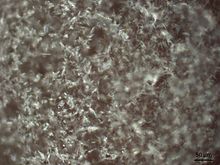


Chocolate bloom is either of two types of whitish coating that can appear on the surface of chocolate: fat bloom, caused by changes in the fat crystals in the chocolate; and sugar bloom, due to crystals formed by the action of moisture on the sugar. Fat and sugar bloom damage the appearance of chocolate but do not limit its shelf life. Chocolate that has "bloomed" is still safe to eat (as it is a non-perishable food due to its sugar content), but may have an unappetizing appearance and surface texture.[1] Chocolate bloom can be repaired by melting the chocolate down, stirring it, then pouring it into a mould and allowing it to cool and re-solidify, bringing the sugar or fat back into the solution.
- ^ Lonchampt, P.; Hartel, Richard W. (2004). "Fat bloom in chocolate and compound coatings". European Journal of Lipid Science and Technology. 106 (4): 241–274. doi:10.1002/ejlt.200400938.